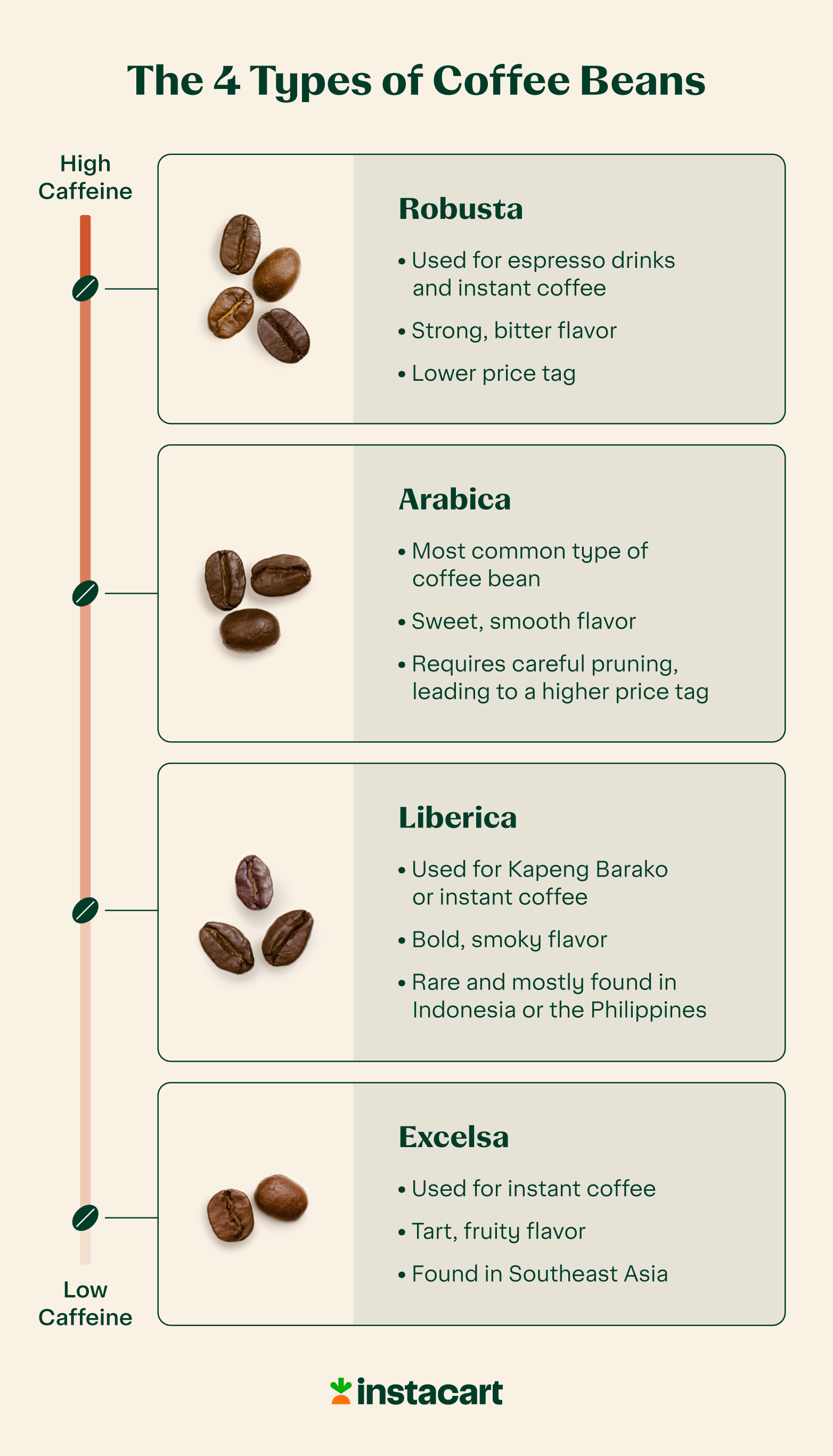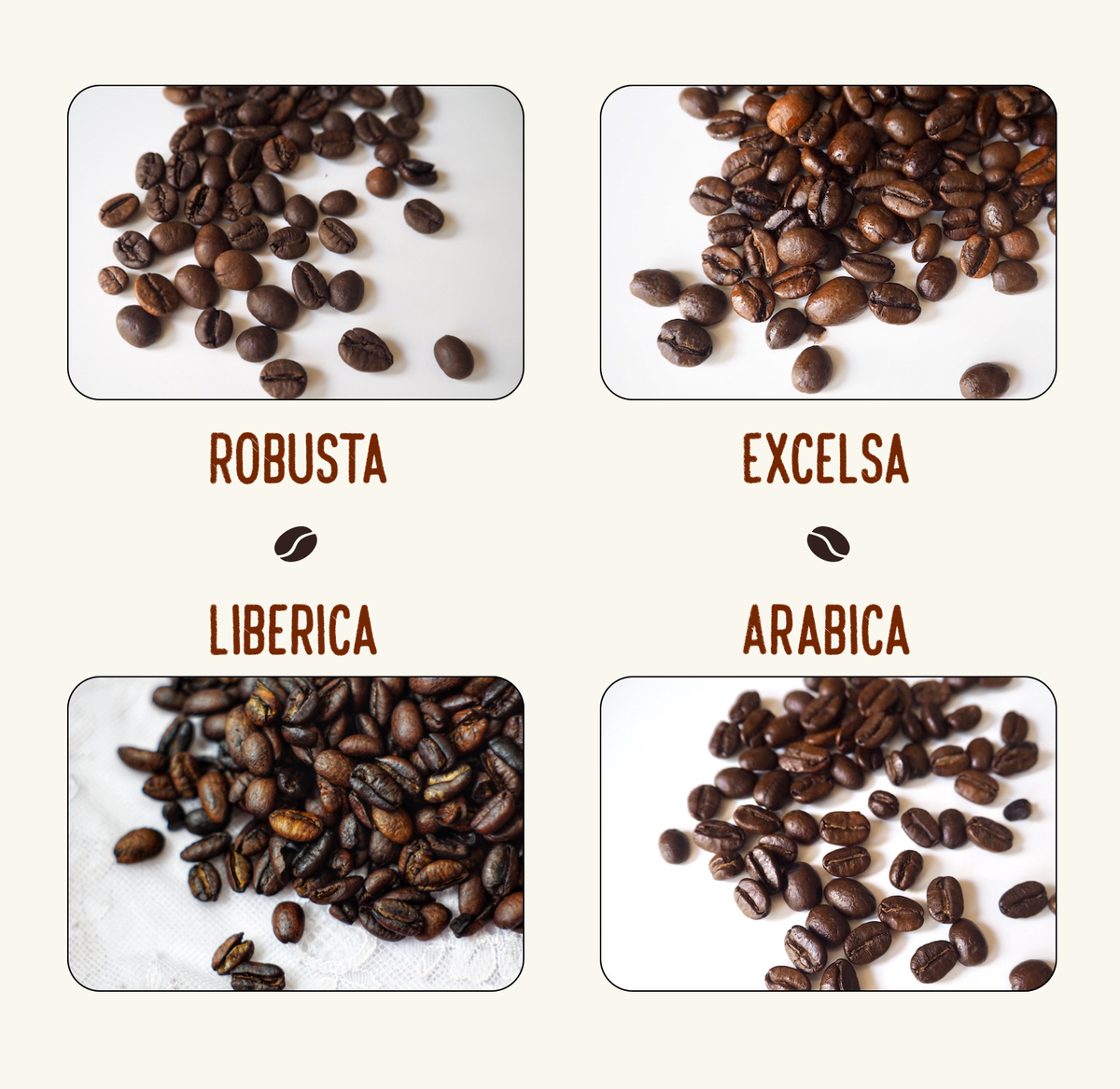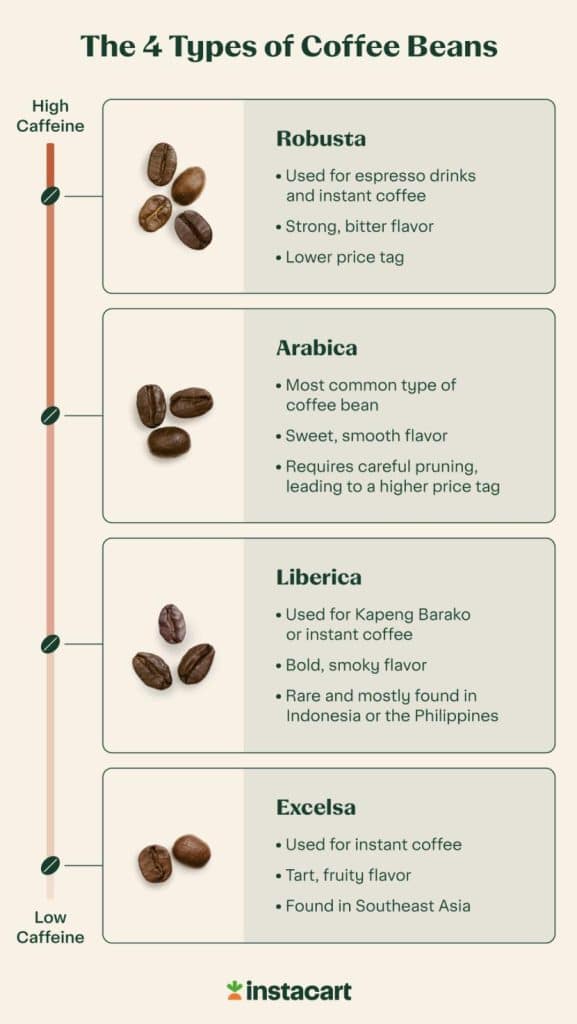Coffee beans are more than just the fuel for our morning caffeine fix; they are a world of flavors waiting to be explored.
In this article, we will uncover the main types of coffee beans and unravel the differences between them.
From the rich and full-bodied Arabica to the bold and intense Robusta, each variety brings unique characteristics to our beloved cup of joe.
So grab your favorite mug, sit back, and join us as we dive into the diverse and flavorful world of coffee beans.

Arabica Coffee Beans
Arabica coffee beans are among the most popular and widely consumed coffee beans globally. They are native to the highlands of Ethiopia and have been cultivated for centuries. Arabica plants require specific growing conditions, thriving in altitudes between 2,000 and 6,000 feet. The ideal temperature range for Arabica plants is between 60 and 70 degrees Fahrenheit, requiring consistent and moderate rainfall.
Arabica coffee beans have distinct characteristics and a unique flavor profile. They are known for their delicate and nuanced flavors, often floral, fruity, and wine-like. Arabica beans have a relatively lower caffeine content than other varieties, making them a popular choice for those who prefer a milder coffee experience. The acidity of Arabica beans varies, with some varieties being more acidic than others. Generally, Arabica coffee is known for its smoothness and pleasant acidity.
There are numerous varieties of Arabica coffee beans, each with its unique characteristics. Some of the most popular varieties include Typica, Bourbon, and Caturra. These varieties have varying flavor profiles, with Typica being known for its sweetness and delicate acidity, Bourbon for its caramel and chocolate notes, and Caturra for its fruity and floral flavors.
Robusta Coffee Beans
As the name suggests, Robusta coffee beans are known for their robust flavor. They are mainly grown in Africa and Asia, with Vietnam being the largest producer of Robusta beans. Robusta coffee plants are more resilient and can withstand a more comprehensive range of growing conditions than Arabica plants. They thrive in low-altitude regions and can tolerate higher temperatures and rainfall fluctuations.
Robusta coffee beans have a distinct and bold flavor profile. They are often described as having earthy, nutty, and woody notes. Robusta beans have a higher caffeine content than Arabica, making them popular for those seeking a solid and energizing cup of coffee. The acidity of Robusta beans is typically lower than that of Arabica beans, giving them a smoother and less acidic taste.
There are several popular varieties of Robusta coffee beans, including Robusta Culi, Robusta Kouilou, and Catimor. These varieties offer different flavor profiles, with Robusta Culi known for its chocolaty and nutty flavors, Robusta Kouilou for its high caffeine content and bold flavor, and Catimor for its balanced flavor with hints of fruitiness.
Liberica Coffee Beans
Liberica coffee beans are a lesser-known variety, often overshadowed by Arabica and Robusta. They originated in Liberia and gained popularity in the Philippines during the late 19th century. Liberica plants require warm and humid climates in regions near the equator. They are relatively large plants with broad and sturdy leaves.
Liberica coffee beans have a distinct and unique flavor profile. They are often described as having a smoky, woody, and floral taste. Liberica beans have a medium to low acidity, giving them a balanced and smooth flavor. However, they are less widely available than Arabica and Robusta, making them a rarity for coffee enthusiasts.
Due to their limited popularity and availability, Liberica coffee beans are less commonly found than other varieties. However, some coffee enthusiasts seek Liberica beans for their distinct flavor and uniqueness. They are often used in specialty and artisanal coffee blends to add complexity and diversity to the flavor profile.
Excelsa Coffee Beans
Excelsa coffee beans are a unique variety often classified as a separate species, Coffea excelsa. They are native to Southeast Asia and are primarily grown in countries such as Vietnam and the Philippines. Excelsa plants thrive in low and high altitudes, making them adaptable to various growing conditions.
Excelsa coffee beans have a unique flavor profile that differentiates them from other varieties. They are often described as having a fruity and tart taste with dark cherry and grapefruit notes. Excelsa beans have a medium acidity level and a distinct aroma that adds depth to the coffee experience.
Excelsa coffee beans are less widely available compared to Arabica and Robusta. They are often used in specialty coffee blends to add complexity and unique flavors. While they may not be as popular as other varieties, Excelsa beans offer a different and exciting option for coffee enthusiasts exploring new flavors.
Characteristics to Consider
When choosing coffee beans, there are several key characteristics to consider, each contributing to the overall coffee experience.
Caffeine Content
Caffeine content varies among different coffee bean varieties. Arabica beans typically have lower caffeine content, making them a popular choice for those who prefer a milder coffee experience or are sensitive to caffeine. Robusta beans, on the other hand, have a higher caffeine content, making them a suitable choice for those seeking a more energizing cup of coffee. Excelsa and Liberica beans fall somewhere in between, with Excelsa having a slightly higher caffeine content than Arabica and Liberica.
Acidity
The acidity of coffee refers to the brightness and tanginess perceived in the flavor. Arabica beans are known for their higher acidity levels, which add a pleasant and lively taste to the coffee. Robusta beans, on the other hand, have a lower acidity level, resulting in a smoother and less tangy flavor. Excelsa and Liberica beans fall somewhere in between, with Excelsa having a medium acidity level and Liberica having a low to medium acidity level.
Body and Mouthfeel
The body of coffee refers to its texture and weight on the palate, while mouthfeel describes the sensations and texture experienced while drinking coffee. Arabica beans have a lighter body and a smoother mouthfeel, providing a delicate and refined coffee experience. Robusta beans have a heavier body, resulting in a more substantial and fuller mouthfeel. Excelsa and Liberica beans also offer unique body and mouthfeel characteristics, with Excelsa having a medium body and Liberica having a medium to heavy body.
Flavor Notes
Flavor notes are the specific tastes and aromas that can be detected in coffee. Each coffee bean variety has its distinct flavor profile, offering a wide range of options for coffee enthusiasts. Arabica beans often exhibit floral, fruity, and wine-like flavors, with hints of chocolate or nuts in certain varieties. Robusta beans are known for their earthy, nutty, and woody flavors. Excelsa beans offer fruity and tart flavors, while Liberica beans have a smoky, woody, and floral taste.
Processing Methods
After harvesting coffee cherries, they use various processing methods to extract the coffee beans from the fruit. Different processing methods can significantly influence the coffee’s final flavor profile and characteristics.
Washed (Wet) Process
In the washing process, the coffee cherries are first sorted and then subjected to fermentation and washing. The beans are pulped to remove the fruit and then fermented in water tanks to remove any remaining pulp. After fermentation, the beans undergo thorough washing to remove any remaining residue. The washing process often yields a cleaner, brighter, and more acidic cup of coffee.
Natural (Dry) Process
The natural process, known as the dry process, involves drying the coffee cherries with the fruit intact. The cherries are laid out to dry in the sun; as they dry, the fruit shrinks and separates from the beans. Once dried, the beans are sorted and processed further. The natural process often results in a sweeter, fuller-bodied cup of coffee with fruit-forward flavors and lower acidity.
Honey (Pulped Natural) Process
The honey process, called the pulped natural process, is a hybrid between the washed and natural processes. The cherries are pulped to remove the skin but left with some fruit pulp intact. The beans are then laid out to dry, similar to the natural process. This process can yield a variety of flavors, depending on the amount of pulp left on the beans. Honey-processed coffees often balance acidity and sweetness with distinct flavor notes.
Semi-Washed (Semi-Dry) Process
The semi-washed process, also known as the semi-dry process, is a variation of the washed process. The coffee cherries are partially pulped in this method, leaving some of the fruit intact. The beans are then fermented and washed like in the washed process. The semi-washed process can result in beans with unique flavors and a balanced acidity and sweetness.
Blend vs. Single Origin
One often comes across options for blends and single-origin coffees when choosing coffee. Understanding the difference between the two can help select the most suitable option.
Definition and Purpose
A blend refers to a combination of different coffee beans from various origins. Blends are carefully crafted to create a specific flavor profile and consistency. They often combine beans from different regions or varieties to achieve a well-rounded and balanced cup of coffee. Blends are preferred by many as they offer a consistent taste experience.
On the other hand, single-origin coffees come from a single geographic location, such as a specific farm, estate, or region. Single-origin coffees highlight the unique characteristics and flavors of a particular growing region or variety. They can offer a more nuanced and diverse coffee-drinking experience, allowing the flavors and attributes of a specific origin to shine.
Advantages and Disadvantages
Blends offer advantages such as consistency, balance, and access to various flavor profiles. Those who enjoy a dependable and uniform coffee experience often prefer them. Blends also allow roasters to achieve a desired flavor profile by combining beans with complementary characteristics.
On the other hand, single-origin coffees offer the advantage of showcasing the distinct flavors and characteristics of a specific origin. They provide a diverse coffee experience, allowing consumers to explore the unique attributes of different regions and varieties. However, the drawback of single-origin coffees is that their flavor profile may vary from harvest to harvest, making it harder to achieve consistent taste.
Ultimately, the choice between blends and single-origin coffees depends on personal preferences. Some may prefer the consistency and balance of blends, while others may enjoy the diversity and complexity of single-origin coffees.
Roast Levels
The roast level of coffee beans significantly impacts their flavor and aroma. Different roast levels bring out distinct characteristics in the beans.
Light Roast
Light roast coffee beans are roasted for a shorter duration and at lower temperatures. This preserves the original flavors and characteristics of the beans, resulting in a brighter and more acidic cup of coffee. Light roast beans often have a lighter body and a pronounced acidity. The flavors can range from fruity and floral to nutty and chocolaty, depending on the origin and variety of the beans.
Medium Roast
Medium roast coffee beans are roasted slightly longer and at slightly higher temperatures than light roast beans. This results in a balanced coffee cup with a medium body, moderate acidity, and a well-rounded flavor profile. Medium roast beans have retained some original flavors while developing additional caramel and chocolate notes. Those seeking a well-rounded and versatile coffee experience often prefer this roast level.
Dark Roast
Dark roast coffee beans are roasted at high temperatures for an extended period. This results in a bolder, fuller-bodied, and less acidic cup of coffee.
Dark roast beans have a rich and smoky flavor profile, often with notes of dark chocolate, caramel, and even charred flavors. The original flavors of the beans are significantly transformed during the roasting process. Dark roast beans are popular among those who enjoy a more robust and intense coffee experience.
Popular Coffee Bean Varieties
Coffee enthusiasts worldwide widely love and enjoy several popular coffee bean varieties. Each variety offers a unique flavor profile and characteristics.
Ethiopian Coffee Beans
Ethiopian coffee beans are highly regarded for their complex and vibrant flavors. They are often known for their fruity and floral profiles, with distinct flavor notes of berries, citrus, and jasmine. Ethiopian coffee beans come from various regions within the country, each offering its own unique taste experience. The diversity and quality of Ethiopian coffee make it a favorite among specialty coffee lovers.
Colombian Coffee Beans
Colombian coffee beans are renowned for their consistency and balanced flavor profiles. They are known for their medium body, acidity, and smooth taste. Colombian coffee often exhibits chocolate, caramel, and nut flavors with citrus undertones. The Colombian coffee-growing regions’ altitude and climate contribute to the beans’ exceptional quality and flavor.
Brazilian Coffee Beans
Brazilian coffee beans are the largest producers of coffee in the world. They are known for their nutty, chocolatey, and low-acidity profiles. Brazilian coffee often offers a medium to entire body, with roasted nuts, cocoa, and caramel flavors. The versatility and affordability of Brazilian coffee make it a popular choice for both commercial blends and specialty coffee.
Costa Rican Coffee Beans
Costa Rican coffee beans are highly regarded for their bright acidity, balanced sweetness, and flavorful complexity. They offer a range of flavor notes, including citrus, honey, floral, and cocoa. Costa Rican coffee is known for its high-quality and carefully cultivated beans, resulting in a rich and delightful drinking experience.
Jamaican Blue Mountain Coffee Beans
Jamaican Blue Mountain coffee beans are considered some of the world’s finest and most sought-after coffee beans. They are grown in the Blue Mountains of Jamaica and are known for their mild flavor, low acidity, and exceptional smoothness. Jamaican Blue Mountain coffee offers subtle flavor notes of chocolate, caramel, and nuts. Due to its limited production and high demand, it is often considered a luxury coffee.
Finding Your Preferred Coffee Bean
Finding your preferred coffee bean involves a combination of experimentation, personal preferences, and expert recommendations.
Experimentation and Tasting
One of the best ways to find your preferred coffee bean is to experiment with different varieties, origins, and roast levels. Try various beans and pay attention to the flavors, acidity, body, and aroma. Take notes of the characteristics you enjoy and those you don’t. This process of trial and error will help you narrow down your preferences and discover the types of coffee that resonate with your taste buds.
Considering Personal Preferences
Consider the flavor profiles and characteristics that you enjoy in coffee. Reflect on whether you prefer a milder, smoother experience or a bold, robust cup. Consider whether you enjoy bright and tangy flavors or the sweetness and balance of medium acidity. By understanding your preferences, you can narrow down the types of coffee beans that are likely to suit your taste.
Seeking Expert Recommendations
If you’re unsure where to start or want to explore more options, seeking recommendations from coffee experts can be invaluable. Visit specialty coffee shops and talk to baristas who can guide you based on their knowledge and experience.
Attend coffee tastings or cupping sessions to expand your palate and gain insights from industry professionals. Expert recommendations can provide valuable guidance, helping you navigate the vast world of coffee.
In conclusion, Arabica, Robusta, Liberica, and Excelsa coffee beans each offer unique characteristics and flavor profiles. Understanding their origin, growing conditions, and processing methods can help you better appreciate the diverse world of coffee.
Consider caffeine content, acidity, body, and flavor notes when selecting your preferred coffee bean. Whether you prefer a single-origin variety or a carefully crafted blend, there is a wide range of options to suit individual preferences. Explore, taste, and enjoy the journey of finding your perfect cup of coffee.







































